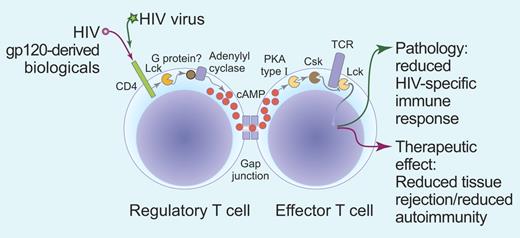Using the HIV gp120 protein as a ligand for CD4, regulatory T cells (Tregs) can be “woken up” from a dormant state and activated to suppress surrounding T cells.
While it has been clear for a long time that CD+CD25+ Tregs need to be activated to exert their suppressive function on bystander effector T cells,1 it has remained elusive how activation of Tregs may occur effectively, as their suppression is not restricted and their antigen specificity may be different from the cells they suppress. In this issue of Blood, Becker and colleagues address this question.2 Starting from earlier reports on anti-CD4–mediated tolerance and Treg activation and their own report on activation of human Tregs through CD4,3 the authors take advantage of the HIV gp120 protein being a high-affinity ligand for CD4 and report that gp120-mediated activation of Tregs through CD4 is sufficient to turn on the suppressive activity of naturally occurring Tregs. They find that the CD4-mediated activation depends on Lck and cyclic adenosine monophosphate (cAMP) production and can be blocked by Src family kinase inhibitors and adenylyl cyclase inhibitors. Furthermore, functional analysis of the effect of gp120-mediated activation of Treg in vivo in a graft-versus-host-disease model demonstrates that the Treg activation by gp120 through adenylyl cyclase and cAMP can abolish the rejection. The data on gp120 are highly interesting in the context of how Tregs may be engaged in bystander suppression in vivo and exciting as a starting point for potential new therapies using gp120-derived biologicals to harness Treg-mediated dampening of autoimmunity and tissue rejection. Furthermore, it is interesting to speculate that the observed Treg-mediated suppression of HIV-specific immunity in HIV-infected patients4 may be elicited by gp120-mediated activation of patient Tregs.
In terms of the link between Lck and the adenylyl cyclase leading to increased cAMP levels in Tregs, earlier reports point to the possibility of TCR-dependent and Lck-dependent recruitment and activation of the α subunit of heterotrimeric G proteins Gs and Gq in effector T cells.5,6 As Gs activates the cyclase, this could (if mechanisms are similar in Tregs) explain how CD4 ligation and subsequent Lck activation could increase cAMP (see figure), although it remains to be shown mechanistically how Lck may activate G proteins. Elevated cAMP levels inside Tregs contribute to their anergic state, but more importantly, may directly suppress effector T cells in a contact-dependent manner by Tregs forming GAP junctions with effector T cells. This establishes a concentration gradient that allows diffusion of cAMP from inside Tregs to inside effector T cells as elegantly shown by some of the same authors in an earlier report (see figure).7 A large body of work has established how cAMP suppresses effector functions through the cAMP–protein kinase A (PKA) type I–C-terminal Src kinase (Csk) inhibitory pathway,8 which is anchored by a scaffold consisting of Ezrin, Ezrin binding protein 50, and the Csk binding protein PAG in T-cell lipid rafts, and completely turns off proximal T-cell receptor mediated signaling by inhibition of Lck (see figure). As a consequence, the HIV virus may, through gp120 ligation of CD4, elicit Treg-mediated suppression of effector T cells, through the cAMP inhibitory pathway, leading to T-cell dysfunction and reduced HIV-specific immune responses. Furthermore, gp120-derived mimics may be used to exploit this mechanism favorably to turn off unwanted immunity (see figure).
A schematic representation of regulatory T cell (Treg) immunosuppression by cAMP following gp120 ligation of CD4. Upon triggering of CD4 on Tregs by gp120 protein or possibly by gp120-derived agonists, Lck becomes active and turns on cAMP production by adenylyl cyclase possibly through interaction with a G protein. cAMP is transferred from Treg to effector T cells through cell-to-cell contacts called GAP junctions that allow diffusion of small molecules down the concentration gradient and into effector T cells. Once inside effector cells, cAMP inhibits immune function through PKA–Csk inhibitory pathway that turns off T-cell activation proximally under the T-cell receptor. This could be damaging in HIV, leading to defective anti-HIV immune responses, but a wanted effect when using gp120-derived agonists to modulate the unwanted immunity in tissue rejection or excessive autoimmune responses. Professional illustration by Paulette Dennis.
A schematic representation of regulatory T cell (Treg) immunosuppression by cAMP following gp120 ligation of CD4. Upon triggering of CD4 on Tregs by gp120 protein or possibly by gp120-derived agonists, Lck becomes active and turns on cAMP production by adenylyl cyclase possibly through interaction with a G protein. cAMP is transferred from Treg to effector T cells through cell-to-cell contacts called GAP junctions that allow diffusion of small molecules down the concentration gradient and into effector T cells. Once inside effector cells, cAMP inhibits immune function through PKA–Csk inhibitory pathway that turns off T-cell activation proximally under the T-cell receptor. This could be damaging in HIV, leading to defective anti-HIV immune responses, but a wanted effect when using gp120-derived agonists to modulate the unwanted immunity in tissue rejection or excessive autoimmune responses. Professional illustration by Paulette Dennis.
Conflict-of-interest disclosure: The author declares no competing financial interests. ■


